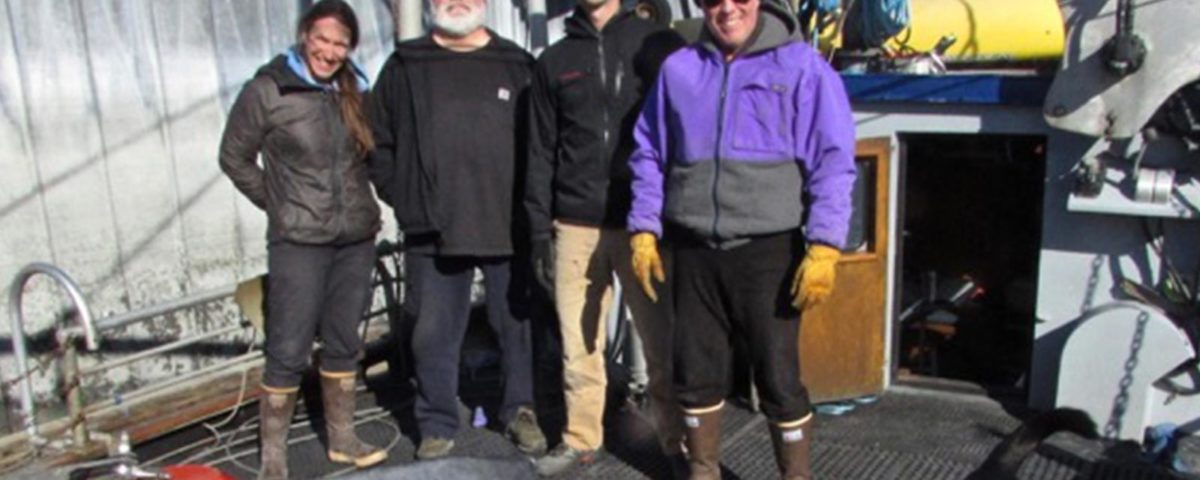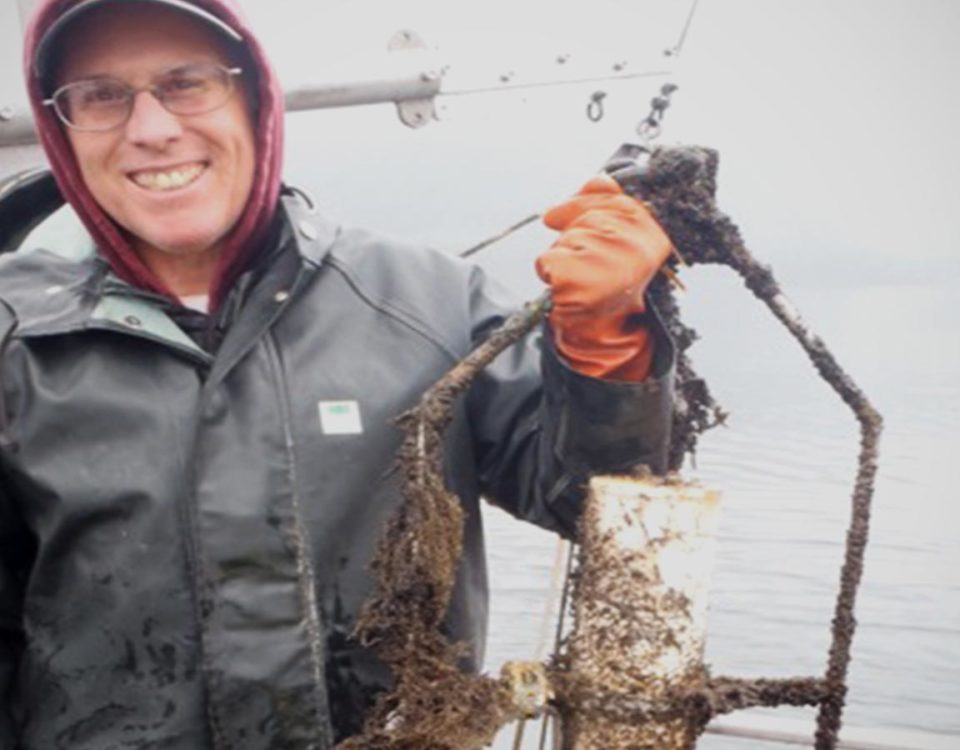CIRCULATION IN PORT VALDEZ, ALASKA

PROJECT
CIRCULATION IN PORT VALDEZ, ALASKA
Background
Port Valdez is a moderately large fjord located in north-central Prince William Sound (PWS), Alaska and gained considerable importance in 1977 as the marine terminal for the Trans-Alaska Pipeline. Since the T/V Exxon Valdez disaster in 1989, prevention of another oil spill has been markedly improved by the addition of dual escort vessels and the requirement that tankers be double hulled. However, there will always remain some danger of a future spill, particularly at the loading facility and terminal located in Port Valdez. For this reason, the Prince William Sound Science Center (PWSSC) conducted a study of circulation within the Port with the objectives of describing and quantifying the currents within the fjord.
The underlying rationale of the study was to obtain more information on the circulation to predict how oil would move within the fjord should there be a spill, determine the potential residency times within the port, and provide a better understanding of the effects of transport on chemically dispersed oil within the upper water column. In addition, the information should aid in the planning of prioritization and tactics related to sensitive area protection strategies. The knowledge gained from this study would also aid in designing and validating any future models of oil movement and general circulation applied to Port Valdez, including the oil spill contingency and response (OSCAR) model, the general NOAA oil modeling environment (GNOME) and regional ocean modeling system (ROMS).
Methods
The study was conducted during three seasons including early summer (June) and fall (September) of 2016 and late winter (March) of 2017. Each season was selected to best characterize the circulation as affected by differing meteorological variables and forcing by winds, tides and spatial variations in water density. The currents were measured by tracking drifter buoys with drogues set to four different depths: surface, 1m, 10m and 40m and making measurements of the flow field using a towed acoustic Doppler current profiler (ADCP). Vertical profiles of temperature and salinity were also collected using a tethered conductivity, temperature and depth (CTD) instrument lowered by a ship’s winch. Ancillary meteorological and tidal data were obtained from archives of the NOAA weather CO-OPS station located in Valdez, Alaska and historical records.
In June drifters were deployed singly at first, then as groups of three during dispersion experiments. In September and March all deployments were conducted in groups of either two or three. Units were released at various regions of the middle and inner basin at points along ADCP transects. The surface and 1m drifters were typically retrieved in one day or less depending on whether they grounded or if they exited the study area, which included the entire fjord up to the western shoreline north of the Narrows.
What We Learned
The results showed that patterns of circulation differed significantly between seasons, with circulation modes in the upper 10 to 25m driven in the summer and fall primarily by winds and horizontal variations in the density (mass) field created by spatial differences in solar heating, freshwater input from cold, glacial sources and limited vertical mixing. In late winter, however, currents in the entire upper 80m were driven primarily by strong down-fjord winds acting on a dense, homogenous water column.
In the summer and fall, a westerly (outflow) current was observed driven by estuarine currents in the upper few meters. These flows were either impeded by daily, westerly sea breezes or enhanced by down-fjord, northeast winds from the interior in June and September respectively. The action of these winds caused changes in circulation modes on the order of hours to days from open and closed cyclonic (counterclockwise) and anticyclonic (clockwise) modes to linear flows oriented primarily along the main channel (i.e. east-west in direction).
In many cases the ADCP data verified the 10m and 40m subsurface drifter flow patterns. For example, in June the ADCP data at 7 to 15m exhibited circulations similar to the 10m drifters in the mid to outer fjord and northern inner basin, with cyclonic flows averaging speeds of 6 to 10cm s-1 (0.12 to 0.19kts) and 5 to 7cm s-1 (0.1 to 0.14kts) respectively. Anticyclonic flows at slightly slower speeds (3 to 4cm s-1) were also observed by both sources in the southeastern inner basin. In contrast, the water at 40m moved very slowly and exhibited mostly small east-west oscillations at along-channel velocities consistent with the tidal currents (~1 to 2 cm s-1). At times of prolonged up-fjord winds, however, the 40m flows accelerated to speeds of ~ 10cm s-1 (0.19kts).
In September the ADCP currents increased to speeds of 25 to 35cm s-1 (~ 0.5 to 0.7kts) and extended to 25 to 30m in depth due to partial mixing and deepening of the seasonal thermocline and halocline . These deeper gradients in the subsurface water (upper 20m) caused nearsurface geostrophic currents ranging from 45 to 100cm s-1, with the highest velocities occurring for stations close to large sources of freshwater discharge, such as the Lowe River and Valdez Glacier Stream. The ADCP data also showed persistent cyclonic circulations at 7 to 23m in depth, also traced by the 10m drifters, but only during the initial deployments on the 21st to the 23rd. In contrast, currents at the surface and 1m were driven primarily by combinations of estuarine flow and down-fjord winds.
In March, the water column had nearly uniform physical properties due to vertical mixing from winds and the sinking of dense, salty surface water . For example, during the first half of the survey strong winds ranging from 12 to 15m s-1 (23 to 29kts) blew from either the southeast (Lowe River Valley) or from the northeast (Valdez Glacier Valley). The surface drifters initially moved to the northwest at speeds ranging from 30 to 45cm s-1 (0.6 to 0.9kts) during the southeast wind events and to the southwest at speeds of 20 to 27cm s-1 (0.4 to 0.5kts) during northeast winds. However, when a period of quiescence ensued near the end of the survey, the circulation modes shown by drifters returned to prominent eddy modes observed in previous months.
In all seasons the north-south (cross-channel) flows were also important and frequently resulted in drifter groundings along the shoreline. In summer and fall, for example, 100% of the surface drifters that exhibited retention grounded within the fjord. In June the average east-west (along-channel) drifter motion generally inferred that retention occurred for 93% of the surface drifters and 75% of the drifters at 1m. The subsurface currents at 10m showed 66% retention but the net eastward motion at 40m indicated that the deep, subsurface water in the inner basin had 100% retention.
Conditions in the fall and winter favored flushing, but in September retention of the surface drifters was still relatively high (62%) due to grounding. In contrast, 85% of the 1m flows in the fall showed complete flushing. In late winter 45% of the surface flows exhibited flushing, but in all cases the drifters grounded before exiting the fjord. In contrast, 72% of the flows at 1m exhibited complete flushing, with only three cases of water moving back into the fjord. In the fall, retention at 10m decreased only slightly with respect to June (55% vs. 66%), but in late winter this layer exhibited 90% flushing. The flows at 40m exhibited 100% flushing along the northern shoreline in both the fall and late winter, but in September two of these drifters also made contact with the northern subsurface benthic zone in the outer fjord.
Although lateral dispersion due to turbulence in Port Valdez typically increased when flows reached the shore as expected, during periods of low winds the large-scale turbulence in the system created mesoscale eddies that gradually dispersed material, but also caused longer retention in comparison to flushing by currents forced by wind and estuarine driven currents. The maximum flushing should therefore occur for the surface and 1m layers, as they exhibited the most rapid down-fjord motions that periodically entered Valdez Arm. In contrast, the deeper flows at 10 and 40m were typically much slower and dispersion at these depths occurred later in the deployments.
Conclusions
A final conclusion of the study regards areas in the fjord especially at risk of contamination from oil, particularly if dispersants were applied allowing it to mix vertically in the water column. Although these sites varied somewhat by season and depth, there was significant overlap in the upper meter, particularly for the early summer and fall periods. In June, for example, thirteen locations were identified as sensitive sites, including various points along the northern shoreline extending from east of Shoup Bay to Gold Creek and Mineral Creek Deltas and along the peninsula one nautical mile to the east; the eastern shoreline from the Valdez Glacier Stream northwards to the ‘Duck Flats’ region; the southeast region from the Lowe River to Solomon Gulch; the southwest shoreline east of Anderson Bay and at Entrance Island; and the entire western shoreline south of Shoup Bay (see Fig. 67a).
In the fall, the sensitive sites included the southwest shorelines at Valdez Narrows, Entrance Island and points east of Anderson Bay; the western shoreline south of Shoup Bay; the northwest shoreline between Shoup Bay and Gold Creek delta; the northeast shoreline both west and east of the harbor entrance and potentially the ‘Duck Flats’ and nearby islands; the eastern shoreline north of the Valdez Glacier Stream; and southeast shoreline near Solomon Gulch (see Fig. 67b).
In late winter, potential ‘sensitive sites’ during high easterly wind events were distributed mainly along the entire northern shoreline extending from one nautical mile east of Mineral Creek all the way to Shoup Bay. During the northeast wind events various points between the Security Zone and Anderson Bay were at risk from surface oil, but during periods of calm or weak westerly winds flows at 1m also turned southwards, and potentially could contaminate the southern side of the fjord (see Fig. 67c).
1.0 EXECUTIVE SUMMARYFig 67a,b Sensitive Areas
Fig. 67c Sensitive Areas (cont.)
PRINCIPAL INVESTIGATOR
Shelton M Gay III, Ph.D.
smg3tx@gmail.com
RESEARCH PERIOD
2010-2017




